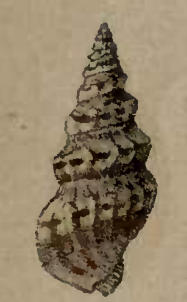Decoradrillia halidorema
| Decoradrillia halidorema | ||||||||||||
|---|---|---|---|---|---|---|---|---|---|---|---|---|

Decoradrillia halidorema under the synonym Drillia pulchella from Manual of Conchology , 1884 |
||||||||||||
| Systematics | ||||||||||||
|
||||||||||||
| Scientific name | ||||||||||||
| Decoradrillia halidorema | ||||||||||||
| Schwengel , 1940 |
Decoradrillia halidorema ( synonym : Fenimorea halidorema ) is a sea snail from the family of Drilliidae thatlivesin the western Atlantic Ocean andeats polychaetes .
description
The height of the shell of the adult snail is between 14 and 25 millimeters. It has nine turns. Its color is pale pink. Striking is a chestnut brown band that runs along the lower part of the turns and is weaker or completely interrupted on the tubercles. In some specimens, a weaker colored geranium-colored pink runs beneath the maroon-brown band, which merges into white at the base.
The sculpture shows fairly broad axial ribs, which, in contrast to the very similar Fenimorea janetae, are smooth and without fine transverse lines. On the last turn, the chestnut brown ribbon runs centrally and uninterrupted over all ten ribs. The protoconch is paucispiral with one and a half whorls, smooth and white.
Occurrence
This species occurs in the shallow water zones of the western Atlantic , from northern Brazil over the Caribbean Sea , e.g. B. off Jamaica and off the coast of Colombia and in the Gulf of Mexico to the coast of Florida .
nutrition
As is with other original conoidea even with Decoradrillia halidorema the loot from Vielborstern (Polychaeta) that using the Radulazähne be caught by lethal injection. The snail is in strong interspecific food competition with other predatory snail species, especially the conoid.
Systematics and taxonomy
The snail was originally described by Reeve in 1845 as Pleurotoma pulchella . In 2016, Fallon placed it in the genus Decoradrillia , which he had newly established .
Individual evidence
- ^ John Tucker: Fenimorea halidorema Schwengel, 1940 In: Mollusca Base (2015). Accessed through: World Register of Marine Species (WoRMS), accessed March 14, 2016
- ↑ George Washington Tyron: Manual of Conchology, structural and systematic, with illustrations of the species . Vol. VI, p. 186 and Fig. 28 in the Pleurotomidae, plate 9, Academy of Natural Sciences, Philadelphia 1884 ( facsimile )
- ^ Jeanne S. Schwengel: New Mollusca from Florida. The Nautilus, 54, pp. 49-52, pl. 3., 1940 (first description, facsimile )
- ^ Edward J. Petuch, Robert F. Myers: Molluscan Communities of the Florida Keys and Adjacent Areas: Their Ecology and Biodiversity. CRC Press, Boca Raton 2014. p. 148.
- ↑ Phillip J. Jr. Fallon: Taxonomic review of tropical western Atlantic shallow water Drilliidae (Mollusca: Gastropoda: Conoidea) including descriptions of 100 new species. Zootaxa, 4090, 1, 2016 doi : 10.11646 / zootaxa.4090.1.1
literature
- Jeanne S. Schwengel: New Mollusca from Florida. The Nautilus, 54, pp. 49-52, pl. 3., 1940 (first description, facsimile )
- George Washington Tyron: Manual of Conchology, structural and systematic, with illustrations of the species . Vol. VI, p. 186 and Fig. 28 in the Pleurotomidae, plate 9, Academy of Natural Sciences, Philadelphia 1884
- John K. Tucker: Catalog of recent and fossil turrids (Mollusca: Gastropoda). Zootaxa, 682, pp. 1-1295, 2004
- G Rosenberg, F. Moretzsohn & EF García: Gastropoda (Mollusca) of the Gulf of Mexico . In: DL Felder & DK Camp (eds.): Gulf of Mexico-Origins, Waters, and Biota. Biodiversity, pp. 579-699, Texas A&M Press, College Station, 2009